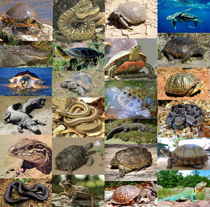
Mississippi Symbols
Mississippi State Reptile
American Alligator

(Alligator Mississippiensis)
Adopted on July 1, 2005.
SB 2060: The American Alligator to be designated as the Mississippi State Reptile; provide. Sen. Tommy Moffatt (Gautier) 02/21- Approved by Governor. Adopted on July 1, 2005. The American alligator (Alligator mississippiensis) is native to the Southeastern United States. Alligator comes from the Spanish "el lagarto" (the lizard). Alligators construct burrows, or "alligator holes" for shelter and hibernation. They are also known to find shelter in swimming pools during the dry months.
Mississippi State Reptile: American Alligator

Adults males typically reach 13 to 14.7 feet, although there are several unconfirmed reports of larger at 16.4 feet and even adults (19.8 feet is the largest "reported", though there are doubts over its veracity) having been found or killed in the 19th and 20th centuries. Such sizes seem unlikely for this species. Females reach lengths of just under 9.8 feet.
The snout is characteristically broad, although this varies slightly between populations. Captive animals have been shown to grow significantly broader jaws compared with wild alligators, mainly due to differences in diet. When the mouth is closed, the edge of the upper jaw overlaps teeth in the lower jaw, which therefore fit into depressions in the upper jaw. This is unlike Crocodylus and Gavialis in which the lower teeth fit into depressions on the outside of the upper jaw. A bony nasal bridge is present, similar to that seen in the spectacled caiman (Caiman crocodilus) but not as pronounced.
Juveniles are essentially miniature versions of their parents, although they possess bright yellow cross-bands on a black background - disruptive camouflage. More western populations (which may have been historically isolated from eastern populations) are reported to have white speckling around the jaws, with paler coloration on their bodies and tails.
Older alligators gradually lose the yellow banding and turn olive brown and black, although areas around the jaws and on the neck and belly are creamy white. The ventral surface is pale, but most scales especially nearer the tail possess significant amounts of black. Ventral osteoderms (bony plates) are present in the belly scales of all American alligators, although the extent varies between populations and the skin is considered quite valuable. The color of the eyes is similar to many other crocodilians, being generally olive green but variable.
Wild adult populations have been observed to fall into two general forms: those which are long and thin, and those which are short and stocky. Variation in growth rate, diet, climate and other factors are likely responsible for these differences.
Common Names
American alligator, Mississippi alligator, Pike-headed alligator, "gator"
Habitat

Primarily freshwater swamps and marshes, but also in rivers, lakes and smaller bodies of water. They can tolerate a reasonable degree of salinity for short periods of time, being occasionally found in brackish water around mangrove swamps, although they lack the buccal salt-secreting glands present in crocodiles.
Construction of burrows is well documented in this species. The burrows are used for shelter and hibernation when the seasonal temperatures fall. Even outside their burrows, they can tolerate limited periods of freezing conditions. They modify their habitat through the creation of 'alligator holes', which provide a refuge for other animals during dry periods. These are excavated using both snout and tail. Once these dry out, however, the alligator crosses land in order to find another body of water. Alligators near human habitation are often seen crossing roads, entering suburbs and finding shelter in swimming pools during the drier months.
Mississippi Legislature
2005 Regular Session
To: Rules
By: Senator(s) Moffatt, Burton, Dawkins, Little, Robertson, Thames
Senate Bill 2060
(As Sent to Governor)
AN ACT TO DESIGNATE THE AMERICAN ALLIGATOR AS THE STATE REPTILE; AND FOR RELATED PURPOSES.
BE IT ENACTED BY THE LEGISLATURE OF THE STATE OF MISSISSIPPI:
WHEREAS, the American Alligator is found in the southeastern United States from Texas to Florida, and from South Carolina to the Gulf Coast. They are
found in both natural and manmade freshwater lakes, ponds, rivers and wetland areas; and
WHEREAS, the Mississippi Department of Wildlife, Fisheries and Parks estimates that there are 32,000-38,000 alligators and about 408,000 acres of alligator
habitat in Mississippi. Alligator reports have come from as far north as Coahoma, Lafayette and Itawamba Counties, and as far south as the coastal
counties of Jackson, Harrison and Hancock; and
WHEREAS, alligators are important to the ecology of their habitat. During droughts, they dig holes, or dens, which provide water for the wildlife community.
The alligators construct these "gator holes" with their large sweeping tails that retain water during periods of drought. This provides water and foraging
space for many other species, such as wading birds; and
WHEREAS, alligators are unique in that, unlike other reptiles, female alligators will protect their young for up to two years after hatching. We feel
this sets a good example for all animal parents. They have proven themselves to be highly resilient to both natural and induced mortality. In fact,
they are known to have existed before the dinosaurs--more than 200 million years ago; and
WHEREAS, alligators are one of the few animals that have been listed as endangered and rallied back again.
SECTION 1. The American Alligator (Alligator Mississippiensis) is hereby designated the State Reptile of Mississippi.
SECTION 2. This act shall take effect and be in force from and after July 1, 2005.
Taxonomic Hierarchy: American Alligator
Kingdom: Animalia
Phylum: Chordata
Class: Reptilia
Superorder: Crocodylomorpha
Order: Crocodilia
Family: Alligatoridae
Genus: Alligator
Species: A. mississippiensis







